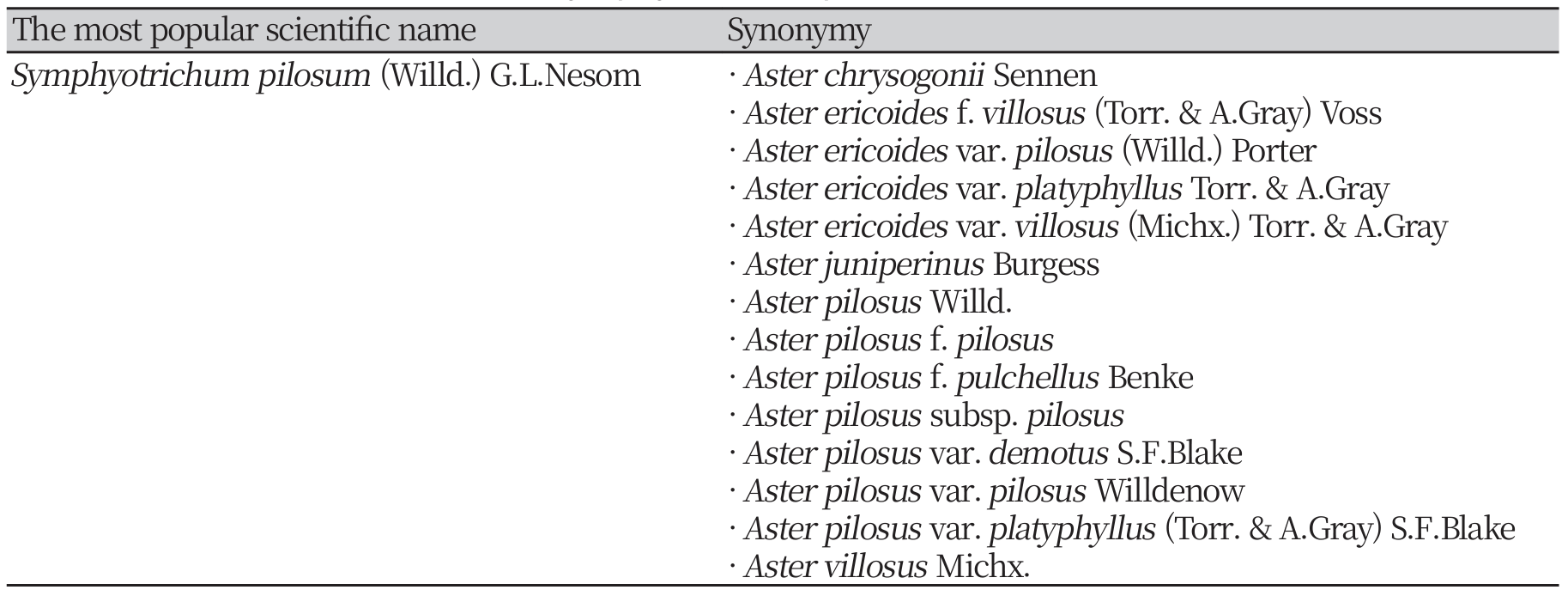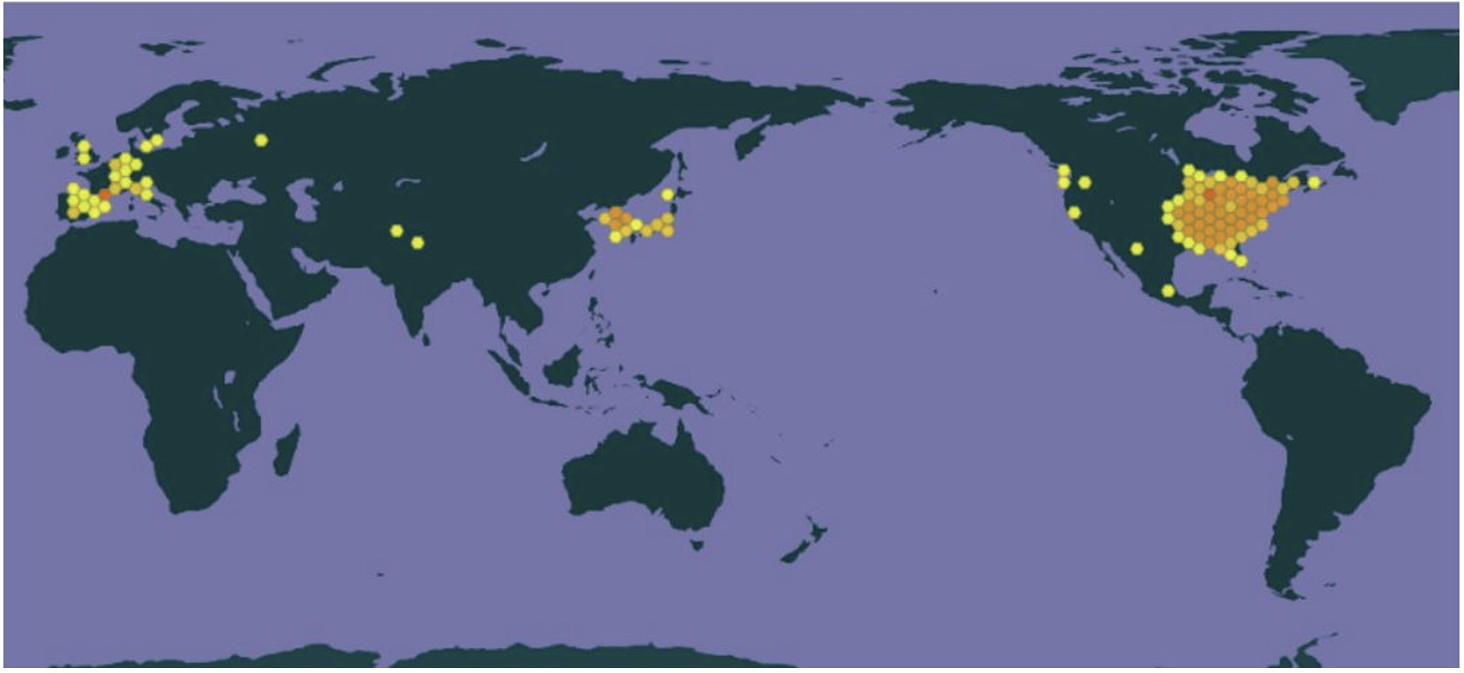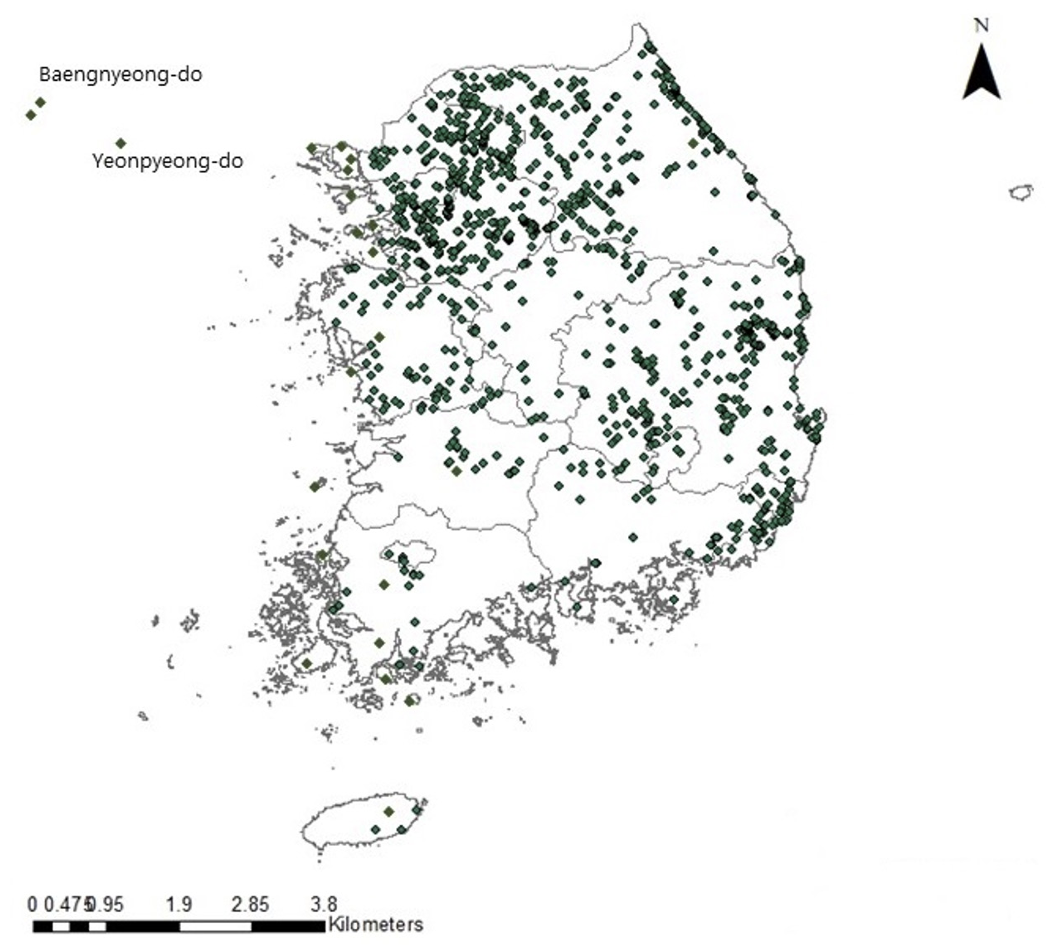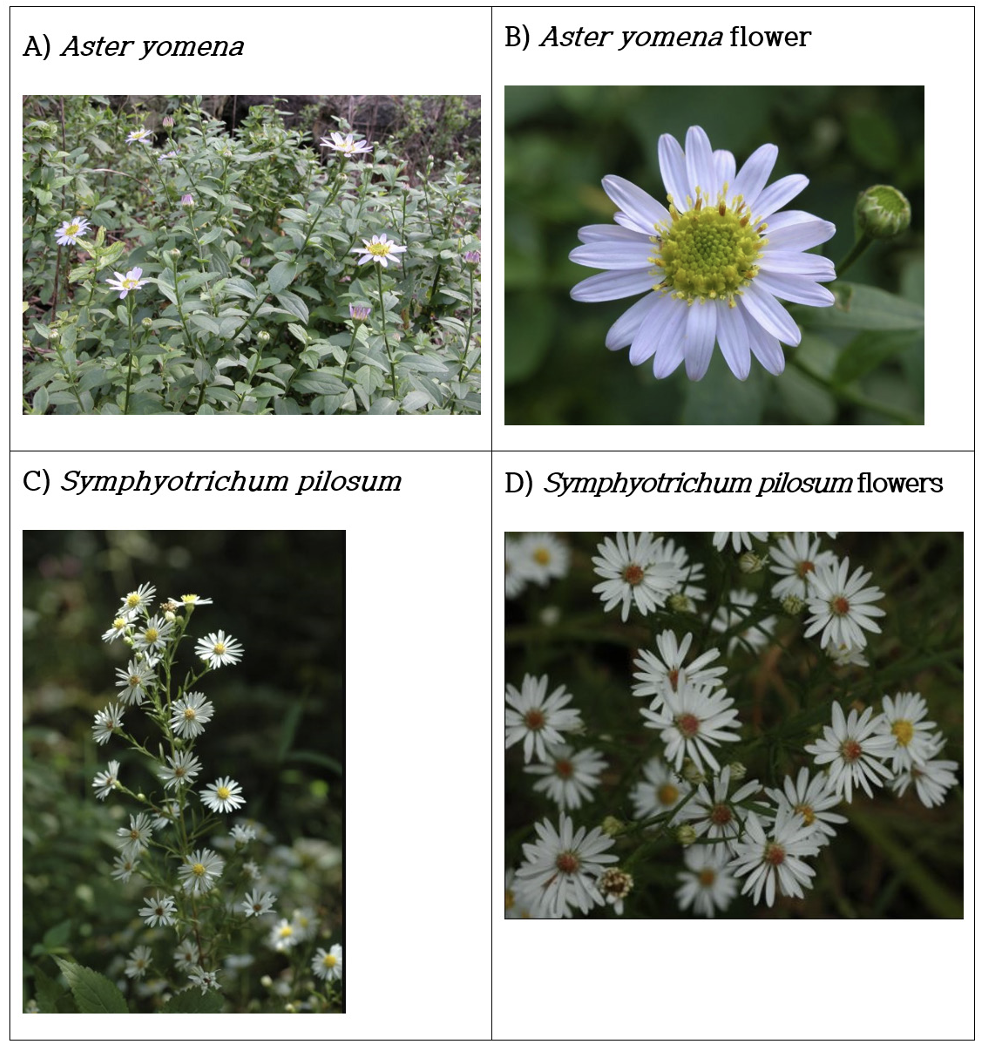서언
생태계교란 생물은 『생물다양성 보전 및 이용에 관한 법률』 (약칭: 생물다양성법)에 의해 환경부장관이 지정·고시하는 것을 말한다(KLIC, 2023). 이 법에 의해 처음으로 적용되어 지정·고시된 생물은 돼지풀(Ambrosia artemisiifolia L.)과 단풍잎돼지풀(A. trifida L.)로 1999년 1월 7일이다. 그 후 몇 차례 추가 지정되어 2023년 9월 24일 현재, 생태계교란 생물은 포유류 1종, 양서·파충류 1속(붉은귀거북속 모든 종) 6종, 어류·갑각류 4종, 곤충류 9종, 식물 17종으로 총 1속 37종이 지정·고시되어 있다(KLIC, 2023).
생태계교란 생물로 처음으로 지정된 돼지풀과 단풍잎돼지풀은 꽃 피는 시기에 꽃가루 알레르기를 유발하고 고밀도 개체군을 형성하여 경제작물의 생육을 크게 저해하거나 주변 식생을 단순화시켜 종 다양성을 저해하는 등의 피해를 준다(ME and NIE, 2021). 생태계교란 식물 17종 중 국화과는 6종[가시상추(Lactuca scariola L.), 돼지풀, 미국쑥부쟁이[Symphyotrichum pilosum (Willd.) Nesom], 서양금혼초(Hypochaeris radicata L.), 양미역취(Solidago altissima L.) 등]으로 전체의 35.2%을 차지하고 있다.
국화과(Asteraceae)는 전 세계에 2만 3천여 종(Wikipedia, 2023), 우리나라에는 864종 발생하고 있다(KNA, 2023). 농경지에 발생하는 잡초 81과 619종 중 국화과는 96종으로 전체의 15.5%를 점유하고 있다(Lee et al., 2017). 그리고 밭에 서식하는 귀화식물은 23과 64속 91종 8변종 중 국화과에 속하는 것이 30분류군으로 전체의 30.3%에 해당된다(Kim et al., 2016a). 이와 같이 국화과는 그 식물의 종류가 많으며, 각 개체별로 생산하는 종자량도 많다. 그리고 일부 종자에는 관모가 있어 바람에 날려 다른 지역으로 분산되어 다른 과보다는 생존할 수 있는 능력이 뛰어나다. 따라서 생태계교란 식물 중 국화과가 우리 주변에 한 두 개체가 보이기 시작하면 금방 주위로 확산될 수 있다.
따라서 우리나라 전역에서 분포하고 확산 중인 국화과 미국쑥부쟁이의 형태와 생리·생태적 특성, 피해양상 및 관리방법 등을 제시하여 효율적으로 관리할 수 있는 기초자료를 제공하고자 한다.
미국쑥부쟁이의 학명과 국명
환경부에서 생태계교란 식물로 미국쑥부쟁이를 추가로 발표할 때 학명을 Aster pilosus Willd.로 하였다(ME and NIE, 2021; KLIC, 2023; NIBR, 2023). 그러나 국내 뿐만 아니라 다른 나라의 논문이나 자료에는 미국쑥부쟁이의 학명을 Symphyotrichum pilosum (Willd.) Nesom으로 사용하고 있다(Yang et al., 2020; Sun et al., 2020; Kim et al., 2021; Lee et al., 2022; EPPO, 2023; GBIF, 2023). Nesom (2023)은 미국쑥부쟁이의 속명(genus) Aster는 독특하고 혀를 비트는 모양(peculiar and tongue-twisting)이기 때문에 Symphyotrichum으로 대체할 것을 1994년에 제안하였다. 이런 제안을 국제식물명명규약(International Plant Names Index and World Checklist of Vascular Plants)에서 받아들여 1995년에 채택되었다(RBG, 2023).
우리나라에서 미국쑥부쟁이에 대한 학명을 보면, 국립생물자원관에서 관리하는 ’한반도의 생물다양성’의 국가생물종목록에는 Aster pilosus Willd. (NIBR, https://species.nibr.go.kr), 산림청 국립수목원의 국가생물종지식정보시스템에는 Symphyotrichum pilosum (Willd.) G.L.Nesom (KNA, www.nature.go.kr)으로 달리 표현하고 있다. 한편, 전 세계 식물명을 공유하는 WFO (The World Flora Online)에서 미국쑥부쟁이의 학명은 Symphyotrichum pilosum (Willd.) G.L.Nesom이 정명(正名)이고, Aster pilosus Willd.는 이명(異名)이라고 기술하였다(www.worldfloraonline.org). 따라서 현재 우리나라에서 사용하는 미국쑥부쟁이의 학명(Aster pilosus)은 1803년에 발표된 것(RBG, 2023)으로 많은 나라에서 사용하고 있는 S. pilosum으로 대체하는 것이 합리적일 것이다. 미국쑥부쟁이의 학명(이명 포함)은 Table 1과 같다.
쑥부쟁이[Aster yomena (Kitam.) Honda는 쑥+부쟁이의 합성어로 잎과 줄기가 쑥처럼 닮았고, 부지깽이처럼 긴 막대기 모양으로 자란다는 뜻에서 유래했다(Cho et al., 2021; iNDICA, 2023). 이런 쑥부쟁이는 조선식물향명집에 수록된 우리나라 자생식물이다(Cho et al., 2021). 국립수목원의 국가표준식물목록에 ’쑥부쟁이’가 들어간 식물로는 가는쑥부쟁이[A. pekinensis (Hance) Chen], 개쑥부쟁이[A. meyendorfii (Regel & Maack) Voss], 갯쑥부쟁이(A. hispidus Thunb.), 눈개쑥부쟁이(A. hayatae H.Lév. & Vaniot), 단양쑥부쟁이(A. altaicus var. uchiyamae Kitam.), 미국쑥부쟁이 등 16종이 있다(KNA, 2023). 이와 같이 다양한 쑥부쟁이류는 우리나라 기후조건에 잘 적응하여 토착화되었고 향후 더 확산할 수 있을 것이다.
우리나라에는 한국전쟁 때에 미국의 군수물자에 묻어 들어왔거나 원예용 식물을 통해 유입된 것으로 추정하는데 1980년 강원도 춘천시 중도에서 처음으로 발견되어 학계에 보고되었다(Kim and Park, 2009; ME and NIE, 2021). 유입 후 강한 번식력과 생명력으로 현재는 우리나라 전역에서 발생하고 있다(Fig. 2). 미국쑥부쟁이는 도로공사장 주변, 그리고 농경지 뿐만 아니라 하천변에도 발생하고 있다(Chu et al., 2017; Kim et al., 2017; Song and Park, 2019). 특히 국립공원 인근에서 복원 및 조경공사를 하는 과정에서 유입된 것으로 추정되어 계룡산, 지리산, 덕유산, 치악산 등에 출현하고 있다(ME and NIE, 2021). 또 육지와 떨어진 연평도(Ryu et al., 2013)와 백령도(NIBR, 2023)에도 발생하고 있다. 즉 제주도 서귀포시 상효동(33°29′)에서 강원도 고성군 하진포(38°28′)까지 우리나라 전역에서 미국쑥부쟁이가 발생하고 있다(NIBR, 2023).
형태적 특성
미국쑥부쟁이의 줄기는 원추형(cone inflorescence)으로 가지를 많이 치고 아래쪽은 목질화된다. 줄기 높이는 30 ~ 100 cm, 작은 가지들은 한쪽을 향하여 배열되고 줄기와는 거의 직각이다. 뿌리에 가까운 잎은 주걱모양이며, 줄기의 잎은 좁은 긴 선형(線形, linear) 또는 선상피침형(線上披針形linear-lanceolate)이다. 잎 끝은 뾰족하고 톱니가 없으며 길이 3 ~ 10 cm, 폭 3 ~ 8 mm이다. 꽃은 9 ~10월에 가지 끝 부위에 지름 10 ~ 17 mm 정도의 꽃이 무리 지어 하얗게 핀다. 모인꽃싸개(總苞, involucre)는 종(bell)모양이고, 꽃싸개(總苞片, involucral scale)은 혁질(革質, 잎의 잎몸이 두텁고, 광택이 있으며 가죽같은 촉감이 있는 것)이고 높이 6 mm이다. 혀모양꽃(舌狀花, ligulate flower)는 15 ~ 25개, 길이 6 ~ 9 mm, 백색 또는 엷은 장미색이다. 열매는 수과(瘦果, achene)이며, 짧은 털이 있고 관모(冠毛, pappus)는 백색이다(Kim and Park, 2009; Park, 2009; ME and NIE, 2021).
미국쑥부쟁이의 외부형태는 쑥부쟁이와 유사하다. 미국쑥부쟁이의 잎은 주걱모양으로 길이 10 cm 내외, 폭 8 mm 정도이며, 잎 가장자리에 털이 자라는 반면에 쑥부쟁이의 잎은 계란형태의 타원 모양으로 길이 3 ~ 8 cm, 폭 3 cm 정도이다. 미국쑥부쟁이는 십 원짜리 동전 크기 정도의 작은 흰색 꽃이 줄기 끝에 가득 달리지만, 쑥부쟁이는 보라색 꽃이 가지 끝에 한 개씩 달린다(ME and NIE, 2021; Fig. 3).
생리·생태적 특성
미국쑥부쟁이에 대한 생리·생태적 특성에 관한 연구는 다른 생태계교란 식물에 비하여 활발하지 않다. 생태계교란 식물 중 가시박에 대한 연구가 상대적으로 많았고(Moon et al., 2007; Lee et al., 2007a; Moon et al., 2008; ME, 2014; Kim et al., 2016b; Kim and You, 2017), 그 다음은 단풍잎돼지풀(Lee et al., 2007b; CABI, 2016; Kwak et al., 2019; Park and Lee, 2018; Lee et al., 2021), 애기수영(Lee et al., 2001; Kim et al., 2003; Lee et al., 2023) 등이었다. 미국쑥부쟁이의 생리·생태적 연구는 종자 발아에 관한 것이 대부분이고 그 밖의 다른 생육 특성에 관한 연구는 거의 전무하다. 그 이유는 전 세계적으로 발생 면적이 넓지 않고, 환경과 인간에 미치는 영향 등이 상대적으로 적었기 때문으로 사료된다.
미국쑥부쟁이는 봄철 뿌리줄기나 종자에서 싹이 트고 자라며, 9~10월경에 꽃이 개화하며, 개체당 3~4만 개의 종자가 생성되고 열매(종자)에는 털이 많아 바람에 의해 널리 분산된다(Kim and Park, 2009; ME and NIE, 2021). 미국쑥부쟁이는 C3식물로 광에 노출시간이 길어질수록 사멸율이 50%에 이르나 그늘 또는 음지가 존재하면 사멸율과 생장 모두 감소시킨다(KEITI, 2022). 미국쑥부쟁이 종자는 명조건의 30/15℃(주야), 30/20℃(주/야), 40/25℃(주/야)의 변온에서 높은 발아율을 나타낸다. 그리고 발아할 때 빛이 필요하다. 매일 하루에 14시간의 일장에 노출시킨 미국쑥부쟁이 종자는 8일 만에 100% 발아한 반면에 계속해서 암조건에 놓아둔 종자는 15일이 되어도 단지 1%만 발아되었다(Baskin and Baskin, 1985; Douglas and Hoffman, 1999). 온실조건에서 미국쑥부쟁이 종자의 발아는 5~7일 만에 최고에 도달된 후 점차 떨어지다가 22일 후에는 발아가 거의 없는 양상을 보인다. 제어된 조건에서 종자의 발아율은 일반적으로 40~80% 범위이지만, 여러 환경조건[빛(irradiance), 토양, 광질(light quality), 영양소, 세포형(cytotype), 온도, 종자 무게(achene weight) 등]에 영향을 받을 수 있다(Chmielewski and Semple, 2001). 그리고 미국쑥부쟁이는 사질토양 등 영양이 풍부하지 않은 토양에서도 생육할 수 있다(ME and NIE, 2021).
위해성 및 피해
미국쑥부쟁이는 한번 자리를 잡으면 전년도에 성장한 뿌리줄기에서 집중적으로 발아하는 특성이 있다. 또 많은 수의 종자로 확산하고 가지를 많이 쳐서 키가 작은 식물들과의 경쟁에서 우위를 점할 수 있다. 그리고 바람에 날린 미국쑥부쟁이 종자는 하천 둔치나 빈터, 또는 들이나 산기슭에 출현하며, 다른 종의 침입이 어려울 정도로 고밀도 개체군을 형성하는 특성이 있다. 이런 생태적 특성으로 미국쑥부쟁이가 정착한 지역의 식생은 단순해지면 종 다양성이 저하된다(ME and NIE, 2021).
미국쑥부쟁이는 캐나다에서는 중요하지 않은 잡초이지만, 미국에서는 문제이다. 미국에서 미국쑥부쟁이는 휴경지, 도로변, 덤불, 채석장, 경작지, 철도상, 제방 등 교란지역에서 70% 이상 발견된다. 펜실베이니아 주에서는 2년 이내에 8 ∼10ha의 밭(휴경지)에 발생하여 문제되고 있다(Keever, 1979; Chmielewski and Semple, 2001). 또 확산 및 교란된 지역에서 생물학적 폐기물로 작용하여 토양 매개 질병으로 작용하거나, 하천오염물질로 수질 환경에 악영향을 끼칠 수 있다(KEITI, 2022).
미국쑥부쟁이에서 추출한 물질은 돼지풀, 야생무(Raphanus raphanistrum), Hieracium pratense의 생육에 영향을 준다(Jackson and Willemsen, 1976; Chmielewski and Semple, 2001). 그리고 미국 남동부지역(Arkansas, Louisiana, 미시시피강 델타)에 발생하는 미국쑥부쟁이는 면화의 주요한 여름 해충(Lygus lineolaris Palis)의 주요 먹이원으로 봄 번식 및 월동 숙주가 되어 문제이다(Tingey and Pillemer, 1977; Chmielewski and Semple, 2001). 반면에 우리나라에서는 미국쑥부쟁이가 특별히 사람이나 동물에게 피해를 준다고 알려진 것은 없다. 도로변에 자란 미국쑥부쟁이는 인근의 밭 주변에도 침입할 수 있다(ME and NIE, 2021). 그러나 밭에서는 경운작업이 1년에 2∼3회 일어나므로 여러해살이인 미국쑥부쟁이가 생육하는데 불리하다. 반면에 과수원에서는 주로 예초작업만 일어나므로 미국쑥부쟁이가 충분히 생육할 수 있다.
관리방안
예방적 관리
ME and NIE (2021)에 따르면, 미국쑥부쟁이 집단 발생지 주변의 바람길과 물길 하류부에 중요한 생태계가 있을 경우에는 예방적 관리 차원에서 우선 관리가 필요한 지역으로 지정하는 것이 중요하다고 하였다.
경종적 관리
미국쑥부쟁이는 농경지에 발생하는 경우가 드물어 경종적 관리방안은 전무하다. 특히 봄과 초여름 동안 경작지에서 발아한 미국쑥부쟁이는 경운에 의해 제거될 수 있다. 실제, 미국 경작지에서 7년 자란 미국쑥부쟁이도 경운(plowing and disking)으로 제거되었다(Chmielewski and Semple, 2001). 미국쑥부쟁이는 뿌리줄기가 길어 완벽하게 제거하기 위해서는 20 cm 이상 깊이로 경운작업을 해야 한다(KEITI, 2022).
물리적 관리
미국쑥부쟁이 줄기를 자르면 새싹이 돋아나므로 생육 초기에 뿌리째 뽑아 제거하는 것이 효과적이다. 즉 미국쑥부쟁이가 발생하는 봄부터 꽃이 피기 전까지 뿌리째 뽑아 제거하는 것이 좋다. 특히 하천변, 도로변 및 초지에서 퍼져 나온 미국쑥부쟁이는 광범위한 확산의 근원지가 되기 쉬우므로 생육 초기에 제거하여야 한다(ME and NIE, 2021). 그리고 뿌리째 뽑는 것이 여의치 않으면 줄기를 잘라 개화하여 종자가 분산되는 것을 막는 것도 중요하다. 미국쑥부쟁이를 제거한 후 반경 50 cm 이내에 뿌리 잔여물 유무를 확인하고 발견했을 때는 추가적으로 제거하여야 재생되는 것을 막을 수 있다.
화학적 관리
미국쑥부쟁이는 농경지보다 도로변, 제방, 비농경지 등에 발생하여 제초제를 이용한 화학적 관리방법은 제한적이다. 캐나다에서는 2,4-D를 미국쑥부쟁이에 반복적으로 살포하여 제어할 수 있다(Anonymous, 2001). 미국에서는 미국쑥부쟁이가 봄에 씨앗이 발아하기 전에는 atrazine, 발아한 후에는 paraquat를 처리하여 방제할 수 있다(Keever, 1979; Chmielewski and Semple, 2001)고 하였다. 또 미국에서는 7년생 미국쑥부쟁이로 오염된 포장에서 쟁기질 후 prometone 또는 atrazine을 처리하면 방제된다(Chmielewski and Semple, 2001). 그러나 쟁기질 작업 후 32.7%의 sodium methyl dithiocarbamate을 1회 또는 3회를 처리하여도 미국쑥부쟁이를 제거하지 못했다(Medve, 1984)는 상반된 보고도 있다.
일반적으로 dicamba, mecoprop 등과 같은 광엽식물 방제용 제초제나 glufosinate-ammonium이나 glyphosate 등의 비선택성 경엽처리형 제초제를 미국쑥부쟁이 잎에 살포하면 방제할 수 있을 것이다. 이들 제초제는 광엽잡초만을 대상으로 한 결과로 실제 미국쑥부쟁이를 대상으로 살포하였을 때에는 그 방제효과는 다를 수 있다. 또 재배하고 있는 농작물에 따라 제초제 사용여부가 결정되어야 한다.
생물학적 관리
미국쑥부쟁이는 초식동물이나 곤충으로 제거하는 방법이 연구되고 있다. 먼저 초식동물로는 작은 설치류(예, Microtus Schrank and Monax Warden)를 방목하면 미국쑥부쟁이의 성장을 줄이고 궁극적으로는 발생밀도를 줄일 수 있다고 하였다(Chmielewski and Semple, 2001).
요약
미국쑥부쟁이는 북미가 원산지인 국화과 다년생식물로 우리나라 전역에서 발생하고 있다. 미국쑥부쟁이는 주로 황무지, 제방, 도로변 등에 발생하며, 간혹 과수원에도 발생하기도 한다. 미국쑥부쟁이는 개체당 3 ~ 4만 개의 종자가 생성되고 열매에는 관모가 있어 바람에 의해 널리 분산된다. 미국쑥부쟁이 종자는 명조건의 30/15℃(주/야) 등의 변온상태에서 높은 발아율을 보인다. 그리고 발아할 때 빛에 반응한다. 미국쑥부쟁이는 전년도에 발생한 곳에서 집중적으로 발생하여 다른 식물의 발생을 막아 종 다양성을 저해하나, 관상용 또는 절화용으로 이용되기도 한다. 전년도에 다발생한 미국쑥부쟁이의 군락을 사전에 제거하는 예방적 방제가 필요하다. 예초나 줄기 절단 등과 같은 물리적 방제도 가능하나 제한적이다. 미국과 캐나다에서 사용하는 paraquat나 atrzine 등의 제초제로 미국쑥부쟁이를 방제할 수 있으나 우리나라에서는 미등록 농약으로 사용할 수 없다. 또 뚜렷하게 생물학적 방제효과가 있는 방제인자도 없다.
Acknowledgement
This study was supported by joint research project from the Ministry of Environment, Republic of Korea (Project number: 2021002270004).
Authors Information
In-Yong Lee, https://orcid.org/0000-0001-7151-7048
Seung-Hwan Kim, Hankyong National University, Senior Researcher
Yong-Ho Lee, Hankyong National University, Senior Researcher; OJeong Resilience Institute, Korea University, Researcher
Adhikari Pradeep, Hankyong National University, Senior Researcher
Adhikari Pradeep, Hankyong National University, Senior Researcher






